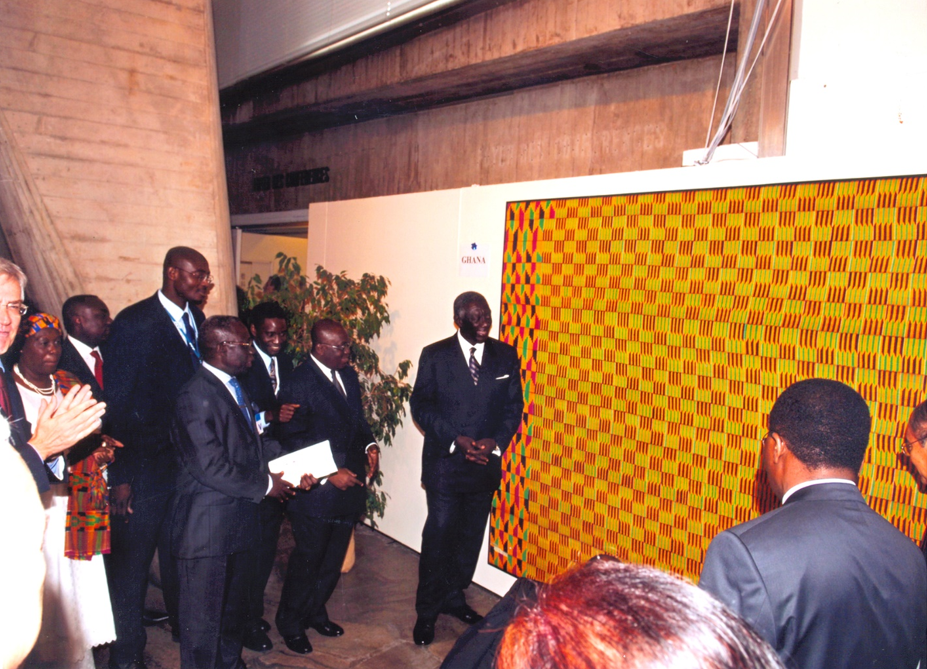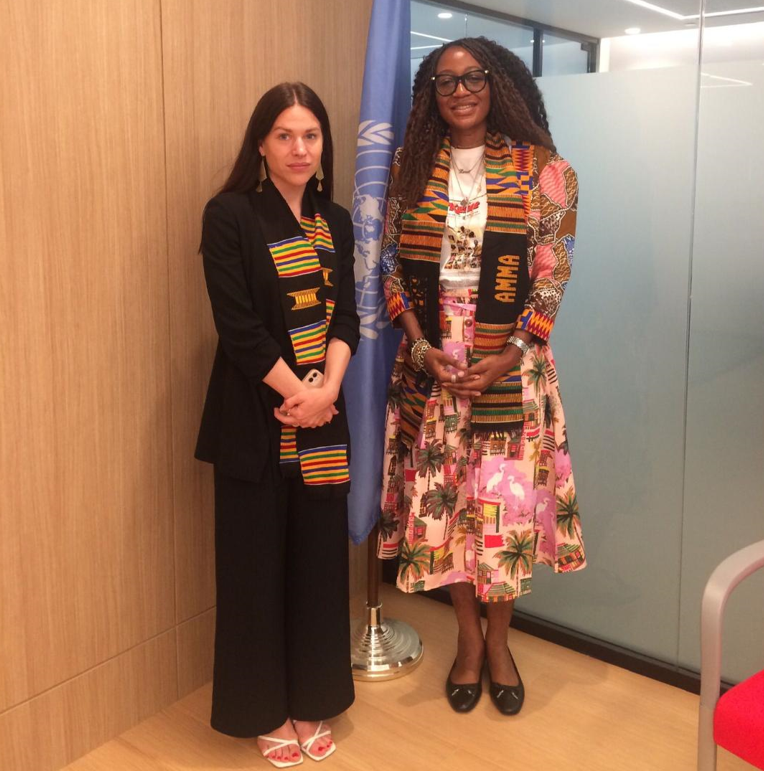Ghanaian textiles evoke powerful emotions. They also symbolize some of the most fundamental human ideals and cultural values. They can cut across ethnic divisions and instill a sense of national pride. Ghanaian traditional textiles represent a significant cultural symbol fostering social cohesion bringing Ghanaians together as one people.
Kente, Ghana’s famous hand-woven cloth has become the best-known and most widely recognized of all African textiles. For Ghanaians, kente cloth epitomizes the finest creativity. Far transcending its material splendor, however, are its intangible properties. Kente has a unique ability to evoke powerful emotions and to symbolize some of the most fundamental human ideals.
Also significant is its value as a unifying symbol for the infinitely heterogeneous sets of people that constitute the African race on the continent and in the Diaspora. Even within Ghana, its capacity to cut across ethnic divisions and instill a sense of national pride is extraordinary. Indeed, kente represents a significant cultural symbol that seems to bring Ghanaians together as one people.
Traditionally, Kente was worn by royalty and during significant ceremonies. Each colour and pattern in Kente carries specific meanings, such as gold for status and serenity, green for renewal, and black for union with ancestors.
During the American election campaign, Amma Prempeh Journalist, Executive Producer, Film Director and Lawyer who was volunteering on Kamala Harris’ Campaign organized & gifted Kamala Harris’ Campaign & supporters with specially handwoven Kente which was commissioned in Bonwire, Ghana and woven by weaver Kumi Boakye Yiadom.

Amma Prempeh conceptualized their design for the weaving which conveyed the following special messages: Wealth, Prudent Management, Truth, Justice, Equity and Fair Play. The colours of the kente were white, blue, black and red; and the designs in it were a gold stool and a measuring rod.
The gold stool represented the wealth of a nation; the evenly distributed horizontal lines were the measuring rod depicting prudent management, Truth, Justice, Equity and Fair Play. Red (koogyan) means seriousness in all undertakings. Blue for peace and harmony. Black (bibire) and White (fufuo) signify racial harmony.
Red, Gold, Green and the Black Star can be found in the Ghana Flag connoting wealth, vitality, seriousness and Pan-Africanism, and Amma Prempeh has created sample Kente for 3 political parties woven by Kwame Manu at Bonwire showing their campaign policies in the sashes which could be a first. The idea is to spotlight Kente in the political discourse and focus on the weaving communities in Ghana which are part of the creative and cultural industries.
Politically, Kente became a symbol of African pride and heritage during the Civil Rights and African Decolonization Movements. It was popularized in the United States when Ghana’s first president, Kwame Nkrumah, wore it during a visit to the White House in 1958.

This act linked Kente to the dignity and political struggles of the African diaspora. Ghana also presented a big Kente Cloth to the UN in New York and UNESCO in Paris.
In contemporary times the wearing of Kente is democratized. Kente is often seen at graduation ceremonies, symbolizing academic achievement and cultural pride. This practice began in the early 1990s and has since spread widely, making Kente a powerful symbol of identity and accomplishment.
On December 4, 2024, Ghana’s Kente was inscribed on the UNESCO Intangible Cultural Heritage List for Humanity. This is indeed a big achievement as it is Ghana’s first inscription under the Convention that seeks to safeguard intangible cultural heritage. The Criteria for Inscription covered:
- Demonstration of Kente constituting an intangible cultural heritage as defined in the Convention.
- Establishment that its survival is at risk despite community efforts, necessitating urgent safeguarding measures.
iii. Highlighting comprehensive safeguarding strategies to ensure the practice and its transmission continue.
iv. Proving that the nomination followed widespread community participation and obtained their free, prior, and informed consent.
v. Confirmation that the element is included in Ghana’s intangible cultural heritage inventory.
What next would Ghana present for nomination and possible inscription? Highlife, Adinkra, Ga and Ewe Symbols? Ghana has a lot to show and give to the world.
Kente is being promoted in many ways including film such as the Kente Culture Story documentary ‘Importance of Kente to Ghanaians & Black Africans’ by Amma Prempeh and the recent ‘Rhythms of da Runway’ event organised in Accra.
Kente as part of Ghana’s cultural assets or resources can be a lever for sustainable development and the required resources need to be invested in its value chain to bring the necessary return on investment.
Latest Stories
-
IPPG calls on Mahama to retain and reset the Emissions Levy
1 hour -
Resetting the Ghanaian Economy: What to focus on
1 hour -
Mahama’s visit to Bawku is critical for lasting peace – National Peace Council
2 hours -
Scores injured in Walewale as soldiers are accused of brutal assault
2 hours -
Mahama meets Mamprugu king over Bawku chieftaincy stalemate
3 hours -
Mahama calls for robust investment to uplift vulnerable populations
3 hours -
Social media hate speeches harming peace efforts in Bawku – Peace Council
3 hours -
Policy Expectations of the New Government: A robust asset and liability declaration framework
3 hours -
Engender trust to resolve Bawku crisis – Former Defence Minister Dominic Nitiwul advises
4 hours -
Guardiola divorces wife of 30 years
4 hours -
Up to 4 in 10 people could develop dementia after 55. What you can do to lower your risk
4 hours -
Mohbad’s widow, father face-off over DNA test
4 hours -
US to remove Cuba from state sponsors of terror list
4 hours -
Jideofor Adibe: Democracy and its Discontents in Africa
4 hours -
Sierra Leone declares emergency over mpox outbreak
5 hours

